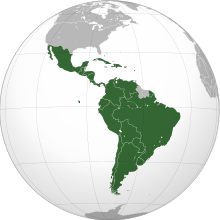
Back Latyns-Amerika Afrikaans ላቲን አሜሪካ Amharic America Latina AN लैटिन अमरीका ANP أمريكا اللاتينية Arabic ܐܡܪܝܩܐ ܠܐܛܝܢܝܬܐ ARC امريكا اللاتينيه ARZ América Llatina AST Latın Amerikası Azerbaijani لاتین آمریکا AZB
This article contains too many charts, tables, or data. |
 | |
| Area | 20,111,457 km2 (7,765,077 sq mi)[1] |
|---|---|
| Population | 656,098,097 (2021 est.)[2][3][a] (3rd by political entity) (4th by continent) |
| Population density | 31/km2 (80/sq mi) |
| GDP (PPP) | |
| GDP (nominal) | |
| Ethnic groups |
|
| Religions |
|
| Demonym | Latin American |
| Countries | [[|]] |
| Dependencies | Puerto Rico |
| Languages |
|
| Time zones | UTC−02:00 UTC−08:00 |
| Largest cities | Largest urban areas: 1. São Paulo 2. Mexico City 3. Buenos Aires 4. Rio de Janeiro 5. Lima 6. Bogotá 7. Santiago 8. Belo Horizonte 9. Monterrey 10. Guadalajara |
| UN M49 code | 419 – Latin America and the Caribbean019 – Americas001 – World |
Latin America refers to a cultural region of the Americas where Romance languages are predominantly spoken, primarily in the form of Spanish and Portuguese (excluding Azores islands), and to a lesser extent, Italian dialects, French (excluding Quebec) and its creoles. There is no precise or official inclusion list. Latin America is defined according to cultural identity, not geography, and as such it includes countries in both North and South America. Most countries south of the United States tend to be included: Mexico and the countries of Central America, South America and the Caribbean. Despite being in the same geographical region, English- and Dutch-speaking countries are sometimes excluded (Suriname, Guyana, the Falkland islands, Jamaica, Trinidad and Tobago, Belize, etc.).[5] In a narrower sense, it often refers to Spanish America plus Brazil.[6][7][8] Related terms are the narrower Hispanic America, which exclusively refers to Spanish-speaking nations, and the broader Ibero-America, which includes all Iberic countries in the Americas and occasionally European countries like Spain and Portugal.
The term Latin America was first introduced in 1856 at a Paris conference titled Initiative of America: Idea for a Federal Congress of the Republics (Iniciativa de la América. Idea de un Congreso Federal de las Repúblicas).[9] Chilean politician Francisco Bilbao coined the term to unify countries with shared cultural and linguistic heritage. It gained further prominence during the 1860s under the rule of Napoleon III, whose government sought to justify France's intervention in the Second Mexican Empire. Napoleon III extended the term to include French-speaking territories in the Americas, such as French Canada, Haiti, French Louisiana, French Guiana, and the French Antillean Creole Caribbean islands (e.g., Martinique, Guadeloupe, Saint Lucia, and Dominica). This broader conceptualization aligned with France’s geopolitical ambitions to categorize these regions alongside the predominantly Spanish- and Portuguese-speaking countries of the Americas.[10]
- ^ "World Development Indicators: Rural environment and land use". World Development Indicators, The World Bank. World Bank. Archived from the original on June 17, 2016. Retrieved September 12, 2013.
- ^ "World Population Prospects 2022". United Nations Department of Economic and Social Affairs, Population Division. Retrieved July 17, 2022.
- ^ "World Population Prospects 2022: Demographic indicators by region, subregion and country, annually for 1950-2100" (XSLX) ("Total Population, as of 1 July (thousands)"). United Nations Department of Economic and Social Affairs, Population Division. Retrieved July 17, 2022.
- ^ a b c d "Report for Selected Countries and Subjects".
- ^ Dressing, David. "Latin America". Encyclopedia of Latin American History and Culture. v. 5, 390
- ^ Bethell, Leslie (August 1, 2010). "Brazil and 'Latin America'". Journal of Latin American Studies. 42 (3): 457–485. doi:10.1017/S0022216X1000088X. ISSN 1469-767X.
- ^ Gistory (September 17, 2015). "Is Brazil Part of Latin America? It's Not an Easy Question". Medium. Retrieved July 17, 2024.
- ^ "Latin America" definition Archived September 22, 2022, at the Wayback Machine. Encyclopedia Britannica, accessed May 20, 2022.
- ^ Bilbao, Francisco (June 22, 1856). "Iniciativa de la América. Idea de un Congreso Federal de las Repúblicas" (in Spanish). París. Archived from the original on September 17, 2017. Retrieved July 16, 2017 – via Proyecto Filosofía en español.
- ^ Britton, John A. (2013). Cables, Crises, and the Press: The Geopolitics of the New Information System in the Americas, 1866–1903. UNM Press. pp. 16–18. ISBN 9780826353986.
Cite error: There are <ref group=lower-alpha> tags or {{efn}} templates on this page, but the references will not show without a {{reflist|group=lower-alpha}} template or {{notelist}} template (see the help page).